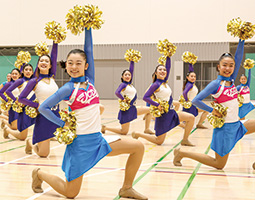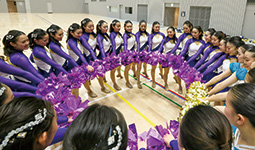Home > Highlighting JAPAN > Highlighting Japan January 2020 > Shall We Dance?
Highlighting JAPAN


Technique and Teamwork Bring Cheer
“Cheer dance” in Japan is growing in popularity as a team sport, and Japanese teams are now winning accolades in world competitions.
The All Japan Cheer Dance Championship was held last year on November 30 and December 1, with 256 qualifying teams from around the country, together comprising more than 3,000 dancers, competing for the titles in twenty-eight categories, including dance type, number of team members and age.
The arena in the suburbs of Tokyo was buzzing with excitement. As each dance team dashed to the center of the floor and posed in their starting position, the audience, which had fallen silent, would erupt at the leader’s opening shout; and as the dancers jumped and moved in step to the music, the arena also resounded to the cheers and handclaps of the audience.
“Cheer dance” derives from cheerleading for sports teams, such as basketball and baseball teams, a style of dance which is purely for entertainment. Cheer dance on the other hand, known as “Performance cheer” or “Song-leading” in other countries, is competitive, with dancers competing, to different degrees of difficulty or perfection, in competitions with a set performance time of up to 2 minutes 30 seconds.
A cheer dance category has four main elements: Pom, which involves dancing in a straight-line movement with a circular decorated ball; Hip hop, having street-dance-type movements and rhythms; Jazz, a ballet-based style of sinuous dancing; and Line dance, in which dancers move in a line with arms around one another’s shoulders. A team’s ability in each of these elements is judged in the Championship and rankings are decided based on the total result.
According to Maeda Chiyo, President of the Japan Cheer Dance Association (JCDA), which organizes the Japan Cheer Dance Championship, anyone can participate in cheer dance as a sport, regardless of sex and age, but most cheer dancers are young women ranging from elementary school students to office workers. Cheer dance is particularly popular among young girls in lower grades who love the gorgeous costumes. Cheer dance also enjoys a good reputation among their parents because it gives young girls the opportunity to learn to act with discipline and cooperativeness. This is why cheer dance is always very popular with elementary school girls.
In Japan, there are several cheer dance organizations other than the JCDA. Teams that achieve good results in some contests get to compete in the US Championship, where Japanese teams have achieved many good results, including victory. Maeda, who has taken the crown in world competitions as a coach, says of the secret to the strength of Japanese national teams, “Just looking at the abilities of the individual dancers, you can tell that there are many performers with outstanding technique in the United States, the home of cheer dance. But you cannot win in a cheer dance with technique alone. Every team member needs to join hands to create the team. That is what makes cheer dance fun and interesting.”
The JCDA conducts activities as Team JCDA as well as holding sport competitions, events and training programs. Team members are selected by the Association through auditions, and activities are pursued with a focus on “showing.” The team cheers at professional baseball and soccer games, collaborates with traditional performing artists such as Japanese classical dancers and taiko drummers, and gives volunteer performances at welfare facilities.
“We will further broaden the possibilities of cheer dance by bringing cheer to people’s lives,” says Maeda.
Currently, cheer dance sports organizations both in Japan and abroad, including the JCDA, are working on establishing consistent international rules and raising the level of cheer dance as a sport with the ultimate aim of making it an Olympic event.
© 2009 Cabinet Office, Government of Japan










